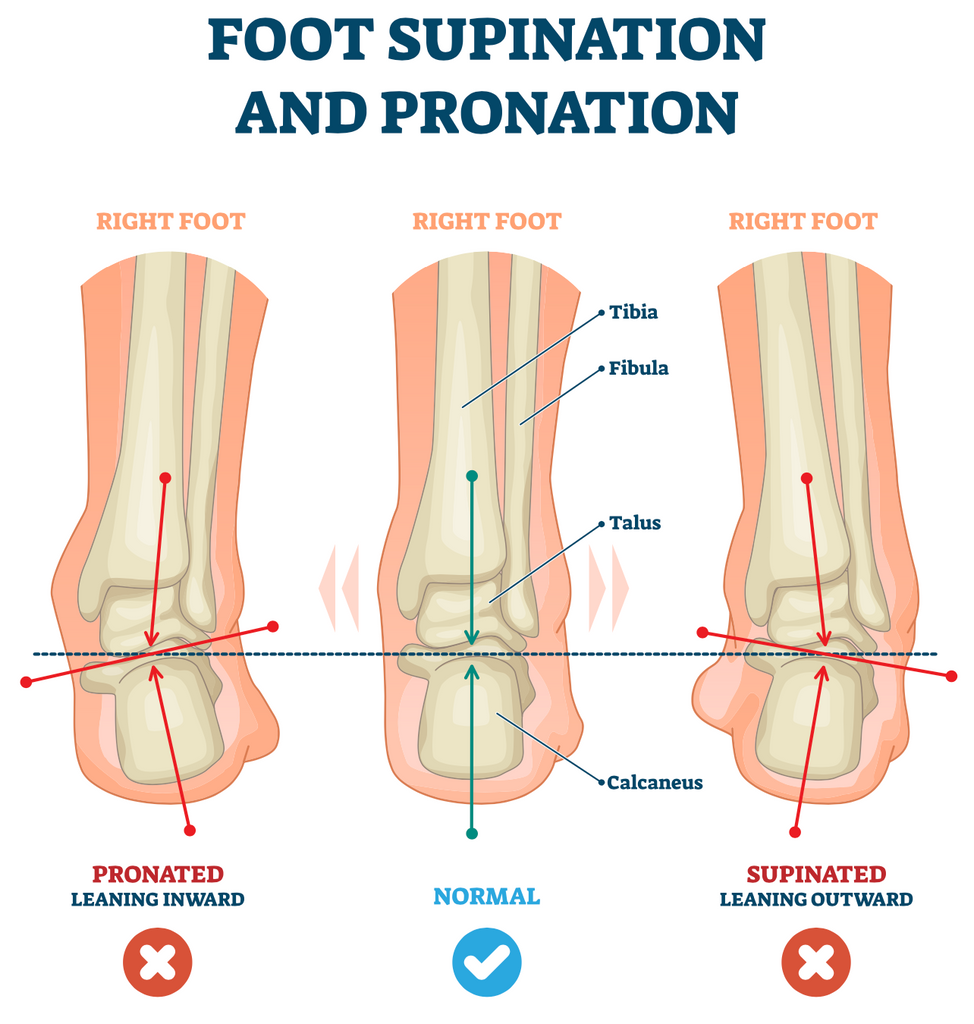Whether you're a runner, lifter, athlete, or weekend warrior, understanding how your body moves is key to optimizing performance and preventing injury. You’ve probably heard your coach, trainer, or physical therapist mention the terms supination and pronation, especially when it comes to how you walk, run, or lift. But what do these terms actually mean—and why should you care?
Supination and pronation describe the natural rotation of your limbs—specifically your feet, arms, and hands—and play a critical role in how your body distributes force, absorbs impact, and maintains balance. These patterns can directly influence your risk of injury, the effectiveness of your workouts, and even your posture.
In this guide, we’re breaking down everything you need to know about supination vs pronation—what it looks like in the feet and arms, how it affects your training, and what you can do to correct or support imbalances. Whether you're trying to avoid ankle sprains, improve your gait, or just lift more efficiently, this is your go-to resource.
Supination vs Pronation: What It Means and Why It Matters
Understanding the Basics
You may have heard the terms pronation and supination either in your healthcare education classes or from your trainer at the gym. These are medical terms used to describe the upward or downward orientation of your arm, foot, or hand.
More specifically, pronation and supination are commonly used to describe:
-
The rotational positioning of your arms
-
The way your weight is distributed when walking or running
Supination means that your weight is distributed more on the outside of your foot.
Pronation means that your weight is distributed more on the inside of your foot during movement.
Supination vs Pronation: The Foot
Some people naturally pronate or supinate with more emphasis toward one side. When this becomes excessive, it can result in discomfort or pain when walking or running.
Overpronation refers to the inward rolling of the foot as it contacts the ground.
Excess supination (also called underpronation) is the outward rolling of the foot, which can place added stress on the:
-
Ankles
-
Heels
-
Balls of the feet
Individuals with excess supination often experience more wear on the outside edge of their shoes. This can result in biomechanical inefficiencies and long-term strain on the lower body.
Common Injuries Linked to Supination
Ankle injuries—particularly sprains—are among the most common athletic injuries. The most common ankle injury is an inversion sprain, which occurs when the ankle goes into too much supination or inversion, stressing the ligaments on the outer ankle.
Two million lateral ankle sprains occur annually in the U.S., often involving the anterior talofibular ligament (ATFL), calcaneofibular ligament (CFL), or posterior talofibular ligament (PTFL) (Fong et al., 2007).
“A common injury associated with excess supination would be rolling your ankles. That is why individuals need to work on reactive balance,” says Katie Gardner, DPT.
Why Reactive Balance Training Matters
Reactive balance refers to your body’s ability to control and respond to sudden shifts in stability. It plays a vital role in preventing falls and acute injuries caused by missteps or uneven surfaces.
Improving reactive balance can help you prevent:
-
Ankle sprains
-
Falls during sport or daily activity
-
Overuse injuries from poor mechanics
One of the most effective ways to build reactive balance is through functional strength training, particularly movements that challenge stability and coordination. Exercises such as lunges, single-leg deadlifts, and plyometric drills can build ankle strength, proprioception, and full-body control.
Want to enhance joint support and recovery? Explore Swolverine’s Joint Supplement and Collagen Protein to strengthen connective tissue and aid injury prevention.
Supporting Foot and Ankle Health
If you notice discomfort when walking or running or see uneven wear on your shoes, it may be time to assess your gait or consult a movement specialist. In the meantime, a few key strategies can help support healthy mechanics:
-
Wear supportive shoes specific to your gait pattern
-
Incorporate balance and ankle-strengthening exercises
-
Use recovery tools and supplements like Swolverine’s Turmeric with BioPerine to manage joint inflammation
-
Prioritize mobility work to keep ankles and feet functional
Understanding your body’s movement tendencies and addressing imbalances early can prevent chronic injury and help you stay active longer.

Supination vs Pronation: The Arms
Understanding Arm Rotation
Pronation and supination of the arms refer to the rotation and positioning of your forearms. When your palms are rotated up, this is supination. When your palms are facing down, this is pronation.
These movements are fundamental in anatomy, kinesiology, and strength training. They influence how you grip, press, and rotate—especially during exercises like curls, pull-ups, and bench pressing.
Anatomy of the Forearm
Your forearms refer to the distal (lower) portion of the arm, stretching from the elbow to the wrist. They contain two long bones:
-
Radius – located on the lateral (thumb) side
-
Ulna – located on the medial (pinky) side in anatomical position
The radius and ulna are connected by multiple ligaments and the interosseous membrane, which help maintain stability and reduce susceptibility to injury.
Supination and Pronation: It’s Not the Wrist
Though the wrist is an extension of the forearm, it does not produce supination or pronation. These movements originate in the forearm, specifically via rotation of the radius around the ulna.
According to Katie Gardner, DPT, “Nearly 25% of all sports-related injuries have something to do with the wrist. For the wrist, a scaphoid fracture is most common—especially in female athletes—but that is due to hyperextension, not supination or pronation.”
Instead, wrist movement typically involves flexion and extension, not rotation.
Need support for joint integrity and wrist strength? Try Swolverine’s Joint supplement or Clean Creatine to improve muscular support and recovery.
Common Questions About Supination vs Pronation
Which Is Worse: Supination or Pronation?
It depends on the context. From a lower-body perspective, excess supination often leads to ankle inversion sprains, the most common ankle injury. This occurs when the ankle rolls outward too far, stressing the anterior talofibular ligament (ATFL). Approximately 2 million lateral ankle sprains occur annually in the U.S., commonly affecting the ATFL, calcaneofibular ligament (CFL), and posterior talofibular ligament (PTFL) (Fong et al., 2007).
In terms of the upper body, neither supination nor pronation is inherently worse, but improper movement mechanics can lead to overuse injuries in the elbow, shoulder, or wrist.
How Do I Know If My Feet Supinate or Pronate?
Check the wear pattern on the soles of your shoes.
-
If there is more wear on the outer edge, you likely supinate.
-
If the inner sole is worn, you may have more pronation.
Understanding this can help guide your choice of footwear and prevent gait-related injuries. Swolverine's Performance Stack can also aid recovery and joint protection for active individuals.
What Is an Example of Supination?
An everyday example: turning your palm up to receive money. Your forearm rotates outward, and the thumb moves laterally—resulting in your palms facing up. That’s supination.
Can Supination or Pronation Cause Knee Pain?
Yes. Both supination and pronation can affect your body’s kinetic chain, meaning misalignment at the feet can travel upward to affect your knees, hips, and lower back. Overpronation may cause internal rotation of the knee, increasing the risk of patellofemoral pain syndrome (PFPS) or IT band syndrome. Excessive supination may reduce shock absorption, leading to knee strain over time.
Can You Fix Supination or Pronation?
In many cases, yes. Corrective measures include:
-
Wearing supportive shoes or orthotics
-
Strengthening the feet, ankles, and glutes
-
Performing mobility work for the lower body
-
Working with a physical therapist or movement specialist
Consistency is key—like any muscular imbalance, it takes time to correct faulty patterns.
Want to support tissue recovery while correcting imbalances? Swolverine’s Collagen Protein can aid joint and tendon health during corrective training.
Do Flat Feet Mean I Pronate?
Not always, but flat feet are often associated with overpronation. Without a natural arch, the foot may collapse inward when bearing weight. However, some people with flat feet do not overpronate, and some with high arches (often linked to supination) may pronate instead. A gait analysis or evaluation by a physical therapist is the best way to know for sure.
Can Supination or Pronation Affect Lifting?
Definitely. Poor alignment from the ground up can affect stability in major lifts like squats, deadlifts, and overhead presses. For example:
-
Excess supination can limit ground contact and reduce stability
-
Overpronation can lead to knee valgus (inward collapse) during squats
Training with awareness of foot positioning and using tools like lifting shoes, orthotics, or barefoot training protocols can improve your movement patterns.
What Type of Shoes Should I Wear?
-
If you overpronate, look for stability shoes with arch support and motion control features
-
If you supinate, choose neutral or cushioned shoes that allow for better shock absorption and correct lateral movement
You can also consult a specialty running store or a podiatrist for shoe recommendations based on your gait.
Supination Vs Pronation: Takeaway
Supination and pronation aren't just anatomical terms—they're movement fundamentals. From the way your feet hit the ground to how your hands grip a barbell, these patterns impact every step, stride, and rep you take. Left unchecked, imbalances can lead to chronic pain, acute injuries, or compromised performance. But with the right awareness, supportive gear, mobility work, and training strategy, you can bring your body back into balance.
Understanding your movement mechanics is the first step. Supporting your body with functional strength training, mobility work, and recovery supplements—like Swolverine's Joint, Collagen, and Clean Creatine—can take your training and injury prevention to the next level.
Want a personalized plan to improve balance, prevent injury, or correct movement patterns? Work 1-on-1 with a coach at The Swole Kitchen and start moving smarter today.








